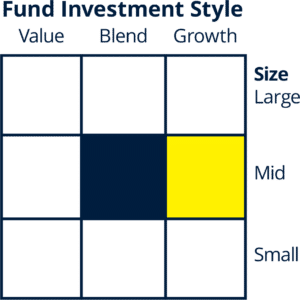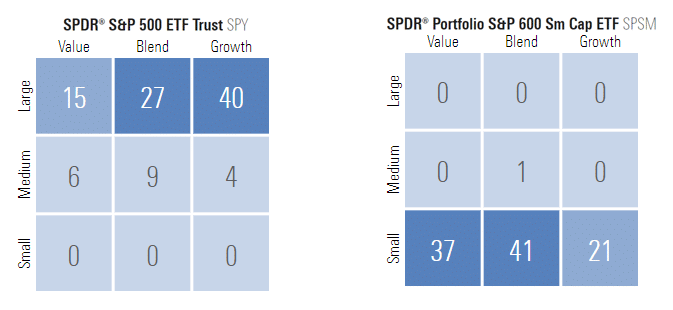Before making any investment, conducting thorough research is essential. The insights gained from your research can reveal an investment’s historical performance, associated risks, and its alignment with your overall financial plan.
When considering mutual funds or exchange-traded funds (ETFs), the Morningstar Style Box™ is an invaluable research tool. Below, we will explore the Morningstar Style Box™ and how to use it to effectively evaluate and compare the composition of mutual funds and ETFs.
What is the Morningstar Style Box™?
The Morningstar Style Box™ is a visual tool designed to help investors understand the investment style of a mutual fund or ETF. It categorizes investments based on company size by market capitalization and investment style whether it be value, growth, or a blend.
Structure of the Morningstar Style Box™
The Morningstar Style Box™ is a 3×3 grid with the following axes shown below:

Vertical Axis : Market Capitalization
This axis divides investments into three categories based on the size of the companies they invest in:
- Large-Cap: Stocks in the top 70% of the capitalization of the U.S. equity market. Think of some of the most notable companies in the world. Disney, McDonald’s, Nike, or Verizon are all large-cap stocks.
- Mid-Cap: The market capitalization range for U.S. mid-caps typically falls between $1 billion and $8 billion and represents 20% of the total capitalization of the U.S. equity market. Some examples of mid-cap stocks are Harley-Davidson, Levi’s, Zillow, and Chewy.
- Small-Cap: Stocks in the bottom 10% of the capitalization of the U.S. equity market. Xerox, Dave & Busters, and JetBlue are all considered small-cap stocks.
Horizontal Axis – Investment Style
This axis categorizes investments based on their style, which can be:
- Value: Investments in companies with low valuations (low price ratios and high dividend yields) and slower growth (low growth rates for earnings, sales, book value, and cash flow). For example, AT&T, Pfizer, Ford, and GM are all considered value stocks.
- Growth: Investments in companies with faster growth (high growth rates for earnings, sales, book value, and cash flow) and high valuations (high price ratios and low dividend yields). Some notable growth stocks would be Apple, Microsoft, and Nvidia.
- Blend (Core): Investments that have a mix of value and growth characteristics. These funds hold a combination of value and growth stocks or those that don’t fit neatly into either category.
Reading the Style Box
The box is divided into nine squares, representing the intersection of the three market cap categories and the three investment styles:
- Top Row (Large-Cap):
- Large Value
- Large Blend
- Large Growth
- Middle Row (Mid-Cap):
- Mid Value
- Mid Blend
- Mid Growth
- Bottom Row (Small-Cap):
- Small Value
- Small Blend
- Small Growth
Example Interpretation

Suppose you are looking at a mutual fund with its style box shaded in the “Mid Growth” square. This tells you that:
- The fund predominantly invests in medium-sized companies.
- These companies are expected to grow at an above-average rate.
Practical Applications – use SPY vs. SPTM
Portfolio Diversification
Use the Style Box to ensure you have a diversified portfolio across different market caps and investment styles. Avoid over-concentration in one area (e.g., only large-cap growth stocks). Understand that different boxes carry different risk levels. For example, small-cap growth funds are generally riskier than large-cap value funds.
Risk Management
Understand that different boxes carry different risk levels. For example, small-cap growth funds are generally riskier than large-cap value funds.
Comparing Funds
Use the Style Box to compare mutual funds or ETFs. Funds in the same style box can be compared more directly as they follow similar investment strategies.

Above are examples of the Morningstar Style Box™ for two different funds, SPY and SPSM. SPY is an ETF that seeks to provide investment results that correspond to the price and yield performance of the S&P 500 Index. SPSM is also an ETF, but it seeks to provide investment results that correspond to the price and yield performance of the S&P SmallCap 600, instead of the S&P 500 Index. Of course, the title of each fund tells you that they are invested in different things, but by looking at the style boxes for each fund you can begin to see the traits of the companies that they hold.
SPY holds mostly large companies, or those that are in the top 70% of the US equity market based on size. SPSM holds almost exclusively small companies. On any given year, these funds can provide different results because the companies that each fund is invested in have different characteristics.
By understanding the Morningstar Style Box™, you can have better knowledge of the investment funds and companies that are included in your portfolio. Interested in analyzing your investment portfolio? Schedule a free consultation today with any of our Certified Financial Planners at HFG Trust.
Brent Schafer, CFP®, Financial Advisor

